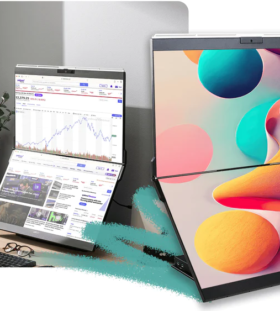How Stacked Monitors are Enhancing Quality Assurance in the Shoe Manufacturing Industry
Quality assurance plays a significant role in shoe manufacturing, where precision and consistency are paramount. The quest for producing flawless footwear has led to the integration of advanced technologies. One such innovation making waves these days is the Geminos stacked monitors.
These systems are revolutionizing how manufacturers ensure quality, from the initial design stages to the final product. This explores the transformative impact of stacked monitor systems on the shoe manufacturing industry’s quality assurance processes
Table of Contents
Benefits of Stacked Monitors in Quality Assurance of Show Manufacturing Industry

Here’s how stacked monitors are enhancing quality assurance in the shoe manufacturing industry:
Better Visual Inspection and Design Precision
One of the significant ways stacked monitor systems enhance quality assurance is by providing unparalleled visual inspection capabilities. Shoe manufacturing involves intricate design elements, from stitching patterns to material texture.
By utilizing stacked monitors, manufacturers can view high-resolution images of these design aspects in real time, allowing for meticulous inspection and adjustments.
In the production of shoes, design accuracy is essential because even the slightest variance might result in aesthetic imperfections or wearer comfort problems. Thanks to stacked monitor systems, designers and quality control workers may quickly spot and fix design flaws.
This level of accuracy accelerates the design iteration process while enhancing the product’s overall quality.
Data-Driven Decision Making
One of the most significant arguments favours integrating stacked monitor systems into quality assurance procedures. In the shoe manufacturing industry, there is a capacity to generate a large amount of valuable data.
These systems meticulously gather and combine data points along the production path, opening up possibilities for data-driven decision-making that were previously unimaginable.
Moreover, stacked monitor systems shed light on production trends, offering valuable insights into patterns that might be overlooked.
By analyzing trends in defect occurrence, production output, and efficiency, manufacturers can make informed strategic decisions to optimize their processes.
The performance of each piece of production equipment may also be evaluated through the data gathered. By examining production outputs, downtimes, and abnormalities, manufacturers can assess the effectiveness and dependability of a piece of machinery.
This information enables prompt maintenance and well-informed decisions about equipment upgrades or replacements, ensuring the production line performs to its full potential.
Real-Time Process
Real-time monitoring is essential in a dynamic production setting. Thanks to stacked monitor systems, manufacturers can keep an eye on several phases of the production process at once.
This reduces the possibility of defective products moving further along the production process by ensuring that any deviations or flaws are discovered in real time. This proactive strategy decreases the need for rework, operational costs, and material waste.
Furthermore, real-time process monitoring allows manufacturers to identify bottlenecks or inefficiencies in the production process.
Production managers can make informed decisions to optimize workflow by analyzing the visual data from stacked monitors. They can allocate resources effectively and enhance overall productivity.

Challenges and Considerations
Here are some of the challenges and considerations that you should keep in mind while using stacked monitors in the quality assurance in a shoe manufacturing industry:
Initial Investment Issues
The advantages of incorporating stacked monitor systems into quality assurance protocols within shoe manufacturing are undeniably promising. Manufacturers are confronted with a set of challenges on the journey towards implementation.
One primary hurdle arises in the form of initial investment costs. The acquisition of the requisite hardware and software components can be substantial. It is potentially presenting a financial barrier for smaller or budget-conscious companies.
The upfront expenditure required for these systems can deter some manufacturers from reaping their benefits despite the long-term advantages they offer.
Enhancement of Skill and Training
It takes a lot of work to train staff members to understand, evaluate, and take action in response to the data. To ensure that the information gathered is turned into improvements that can be implemented, manufacturers must invest resources in teaching essential skills to their workers. The need for continuous education and skill development adds an ongoing dimension to this challenge.
Calibration and Maintenance
Ensuring the accuracy and reliability of the data provided by stacked monitor systems is very important. They all fall in the category of calibration and maintenance.
This introduces an ongoing challenge that manufacturers must address proactively. Regular upkeep, such as calibrating the sensors for monitors and data interfaces, is essential to preserve the systems’ accuracy.
Final Thoughts
The integration of stacked monitors is reshaping quality assurance in shoe manufacturing. These monitors offer précised design inspection, real-time process monitoring, and data-driven decision-making.
They empower manufacturers to detect defects, optimize processes, and enhance design accuracy. However, challenges like initial investment and skill development must be addressed. Despite hurdles, stacked monitors collaboration with technology, moving the industry toward a future of impeccable quality and efficiency.




